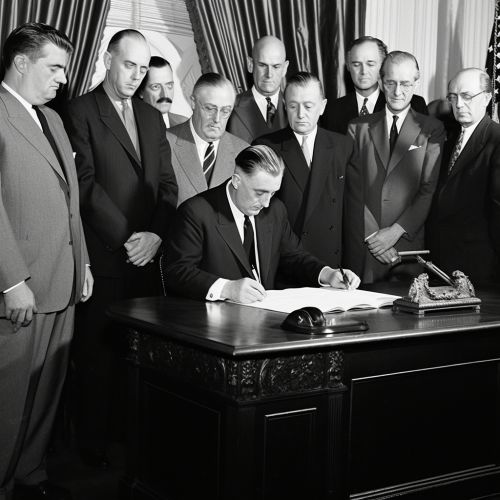Wagner Act
Introduction
The Wagner Act, officially known as the National Labor Relations Act (NLRA), was a significant piece of legislation in the United States that greatly impacted the field of labor law. Named after its sponsor, Senator Robert Wagner of New York, the act was signed into law by President Franklin D. Roosevelt on July 5, 1935, as part of his New Deal program.


Background
During the Great Depression, the United States faced unprecedented economic challenges. In response to these challenges, President Roosevelt proposed the New Deal, a series of programs, public work projects, financial reforms, and regulations. The Wagner Act was a key component of this initiative, designed to protect the rights of workers and to stabilize labor relations.
Provisions of the Act
The Wagner Act established several key principles and provisions. First, it affirmed the right of employees to form, join, or assist labor organizations, to bargain collectively through representatives of their own choosing, and to engage in concerted activities for the purpose of collective bargaining or other mutual aid or protection. This provision effectively legalized the formation of trade unions and protected the rights of workers to engage in collective bargaining.
Second, the act established the National Labor Relations Board (NLRB), a federal agency tasked with enforcing the provisions of the act. The NLRB was given the authority to prevent and remedy unfair labor practices committed by private sector employers and unions.
Third, the act defined a set of unfair labor practices, which included interfering with, restraining, or coercing employees in the exercise of their rights; dominating or interfering with the formation or administration of any labor organization; and refusing to bargain collectively with the representatives of the employees.
Impact and Significance
The Wagner Act had a profound impact on labor relations in the United States. It significantly increased the power of labor unions, leading to a dramatic increase in union membership and a shift in the balance of power between labor and management. The act also established a legal framework for collective bargaining, which has shaped labor relations in the United States to this day.
However, the act was not without controversy. Many employers opposed the act, arguing that it gave too much power to unions and infringed upon their rights. The act was also challenged in court, leading to a landmark Supreme Court case, NLRB v. Jones & Laughlin Steel Corporation, in which the court upheld the constitutionality of the act.
Amendments and Subsequent Legislation
In the years following the passage of the Wagner Act, several amendments and pieces of subsequent legislation were passed to address perceived shortcomings and to respond to changing economic and political conditions. The most significant of these was the Taft-Hartley Act of 1947, which amended the Wagner Act to balance the rights of employers and unions and to address concerns about union corruption and abuse of power.
Conclusion
The Wagner Act remains a cornerstone of labor law in the United States. Despite numerous amendments and changes over the years, the core principles of the act - the right of workers to form unions and to engage in collective bargaining - remain intact. The act continues to shape labor relations in the United States, and its impact can be seen in the ongoing debates over labor rights and the role of unions in the modern economy.
